#also Michael Parkinson
Explore tagged Tumblr posts
Text
Denny’s death hit me more than I expected it to :( I remember when I discovered the Wings and thought the guitar was just superb. December can’t be easy for Paul whew
#he’s losing so many people these days good Lord#when Jimmy buffet died and he started his post with ‘it seems that so many wonderful people are leaving this world’#also Michael Parkinson#tony bennet as well#burt Bacharach#although I don’t believe they were friends I think he admired him though#Jeff beck#Carl Davis#and those are just the people he posted about this year that I remember off the top of my head#also John Eastman last year#now imagine the people we don’t know about :( poor Paul I hate to think he’s used to losing people by now#and just in time when we’re celebrating Band on the run fuck offffff this is terrible#mine#emmys thoughts#denny laine
13 notes
·
View notes
Text
.
#just my opinion but#I think George Michael’s interview on the Parkinson Show#from 1998#is worth watching#he talks about being a pop star#about his relationship with the media#about what people would assume any time he was spotted in public with a female friend#about his sexuality#about coming out#anyway it’s interesting and I also just love listening to him talk#you can find it on yt
7 notes
·
View notes
Text
Crowdfunding Spotlight: LOLZ no. 2, from The77 Publishing
There's still time to support The77 Publishing's second issue of their humour comic, LOLZ, "for all readers aged 7 - 77" – but the clock is ticking!
#among others#Andrew Richmond#Anna Everts#David Thomas#downthetubes News#Humour Comics#LoLz#LOLZ 2 also includes strips by#Michael Powell#Mike Collins#Nigel Parkinson#Sonia Leong#SP Zero#The77 Publishing
1 note
·
View note
Text
Oooh! A great Gavin Finney (Good Omens Director of Photography) interview with Helen Parkinson for the British Cinematographer! :)
HEAVEN SENT
Gifted a vast creative landscape from two of fantasy’s foremost authors to play with, Gavin Finney BSC reveals how he crafted the otherworldly visuals for Good Omens 2.
It started with a letter from beyond the grave. Following fantasy maestro Sir Terry Pratchett’s untimely death in 2015, Neil Gaiman decided he wouldn’t adapt their co-authored 1990 novel, Good Omens, without his collaborator. That was, until he was presented with a posthumous missive from Pratchett asking him to do just that.
For Gaiman, it was a request that proved impossible to decline: he brought Good Omens season one to the screen in 2019, a careful homage to its source material. His writing, complemented by some inspired casting – David Tennant plays the irrepressible demon Crowley, alongside Michael Sheen as angel-slash-bookseller Aziraphale – and award-nominated visuals from Gavin Finney BSC, proved a potent combination for Prime Video viewers.

Aziraphale’s bookshop was a set design triumph.
Season two departs from the faithful literary adaptation of its predecessor, instead imagining what comes next for Crowley and Aziraphale. Its storyline is built off a conversation that Pratchett and Gaiman shared during a jetlagged stay in Seattle for the 1989 World Fantasy Convention. Gaiman remembers: “The idea was always that we would tell the story that Terry and I came up with in 1989 in Seattle, but that we would do that in our own time and in our own way. So, once Good Omens (S1) was done, all I knew was that I really, really wanted to tell the rest of the story.”
Telling that story visually may sound daunting, but cinematographer Finney is no stranger to the wonderfully idiosyncratic world of Pratchett and co. As well as lensing Good Omens’ first outing, he’s also shot three other Pratchett stories – TV mini series Hogfather (2006), and TV mini-series The Colour of Magic (2008) and Going Postal (2010).
He relishes how the authors provide a vast creative landscape for him to riff off. “The great thing about Pratchett and Gaiman is that there’s no limit to what you can do creatively – everything is up for grabs,” he muses. “When we did the first Pratchett films and the first Good Omens, you couldn’t start by saying, ‘Okay, what should this look like?’, because nothing looks like Pratchett’s world. So, you’re starting from scratch, with no references, and that starting point can be anything you want it to be.”
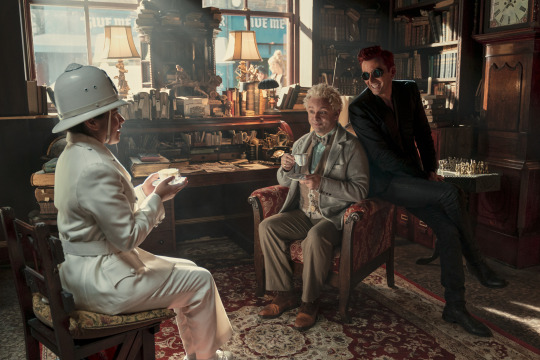
Season two saw the introduction of inside-outside sets for key locations including Aziraphale’s bookshop.
From start to finish
The sole DP on the six-episode season, Finney was pleased to team up again with returning director Douglas Mackinnon for the “immensely complicated” shoot, and the pair began eight weeks of prep in summer 2021. A big change was the production shifting the main soho set from Bovington airfield, near London, up to Edinburgh’s Pyramids Studio. Much of the action in Good Omens takes place on the Soho street that’s home to Aziraphale’s bookshop, which was built as an exterior set on the former airfield for season one. Season two, however, saw the introduction of inside-outside sets for key locations including the bookshop, record store and pub, to minimise reliance on green screen.
Finney brought over many elements of his season one lensing, especially Mackinnon’s emphasis on keeping the camera moving, which involved lots of prep and testing. “We had a full-time Scorpio 45’ for the whole shoot (run by key grip Tim Critchell and his team), two Steadicam operators (A camera – Ed Clark and B camera Martin Newstead) all the way through, and in any one day we’d often go from Steadicam, to crane, to dolly and back again,” he says. “The camera is moving all the time, but it’s always driven by the story.”
One key difference for season two, however, was the move to large-format visuals. Finney tested three large-format cameras and the winner was the Alexa LF (assisted by the Mini LF where conditions required), thanks to its look and flexibility.
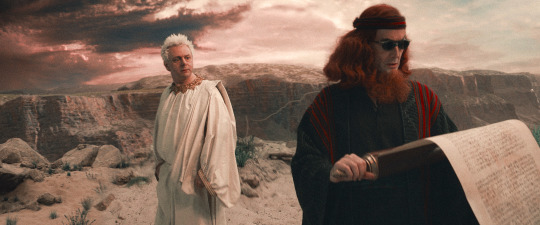
The minisodes were shot on Cooke anamorphics, giving Finney the ideal balance of anamorphic-style glares and characteristics without too much veiling flare.
A more complex decision was finding the right lenses for the job. “You hear about all these whizzy new lenses that are re-barrelled ancient Russian glass, but I needed at least two full sets for the main unit, then another set for the second unit, then maybe another set again for the VFX unit,” Finney explains. “If you only have one set of this exotic glass, it’s no good for the show.”
He tested a vast array of lenses before settling on Zeiss Supremes, supplied by rental house Media Dog. These ticked all the boxes for the project: “They had a really nice look – they’re a modern design but not over sharp, which can look a bit electronic and a bit much, especially with faces. When you’re dealing with a lot of wigs and prosthetics, we didn’t want to go that sharp. The Supremes had a very nice colour palette and nice roll-off. They’re also much smaller than a lot of large-format glass, so that made it easy for Steadicam and remote cranes. They also provided additional metadata, which was very useful for the VFX department (VFX services were provided by Milk VFX).”
The Supremes were paired with a selection of filters to characterise the show’s varied locations and characters. For example, Tiffen Bronze Glimmerglass were paired with bookshop scenes; Black Pro-Mist was used for Hell; and Black Diffusion FX for Crowley’s present-day storyline.

Finney worked closely with the show’s DIT, Donald MacSween, and colourist, Gareth Spensley, to develop the look for the minisode.
Maximising minisodes
Episodes two, three and four of season two each contain a ‘minisode’ – an extended flashback set in Biblical times, 1820s Edinburgh and wartime London respectively. “Douglas wanted the minisodes to have very strong identities and look as different from the present day as possible, so we’d instantly know we were in a minisode and not the present day,” Finney explains.
One way to shape their distinctive look was through using Cooke anamorphic lenses. As Finney notes: “The Cookes had the right balance of controllable, anamorphic-style flares and characteristics without having so much veiling flare that they would be hard to use on green screens. They just struck the right balance of aesthetics, VFX requirements and availability.” The show adopted the anamorphic aspect ratio (2:39.1), an unusual move for a comedy, but one which offered them more interesting framing opportunities.

Good Omens 2 was shot on the Alexa LF, paired with Zeiss Supremes for the present-day scenes.
The minisodes were also given various levels of film grain to set them apart from the present-day scenes. Finney first experimented with this with the show’s DIT Donald MacSween using the DaVinci Resolve plugin FilmConvert. Taking that as a starting point, the show’s colourist, Company 3’s Gareth Spensley, then crafted his own film emulation inspired by two-strip Technicolor. “There was a lot of testing in the grade to find the look for these minisodes, with different amounts of grain and different types of either Technicolor three-strip or two-strip,” Finney recalls. “Then we’d add grain and film weave on that, then on top we added film flares. In the Biblical scenes we added more dust and motes in the air.”
Establishing the show’s lighting was a key part of Finney’s testing process, working closely with gaffer Scott Napier and drawing upon PKE Lighting’s inventory. Good Omens’ new Scottish location posed an initial challenge: as the studio was in an old warehouse rather than being purpose-built for filming, its ceilings weren’t as high as one would normally expect. This meant Finney and Napier had to work out a low-profile way of putting in a lot of fixtures.
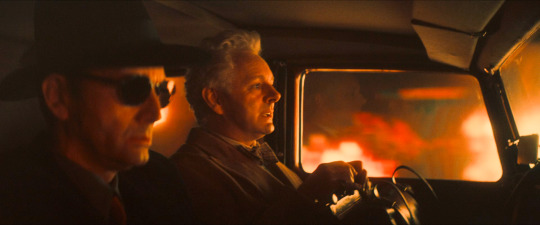
Inside Crowley’s treasured Bentley.
Their first task was to test various textiles, LED wash lights and different weight loadings, to establish what they were working with for the street exteriors. “We worked out that what was needed were 12 SkyPanels per 20’x20’ silk, so each one was a block of 20’x20’, then we scaled that up,” Finney recalls. “I wanted a very seamless sky, so I used full grid cloth which made it very, very smooth. That was important because we’ve got lots of cars constantly driving around the set and the sloped windscreens reflect the ceiling. So we had to have seamless textiles – PKE had to source around 12,000 feet of textiles so that we could put them together, so the reflections in the windscreens of the cars just showed white gridcloth rather than lots of stage lights. We then drove the car around the set to test it from different angles.”
On the floor, they mostly worked with LEDs, providing huge energy and cost savings for the production. Astera’s Titan Tubes came in handy for a fun flashback scene with John Hamm’s character Gabriel. The DP remembers: “[Gabriel] was travelling down a 30-foot feather tunnel. We built a feather tunnel on the stage and wrapped it in a ring of Astera tubes, which were then programmed by dimmer op Jon Towler to animate, pulse and change different colours. Each part of Gabriel’s journey through his consciousness has a different colour to it.”
Among the rigs built was a 20-strong Creamsource Vortex setup for the graveyard scene in the “Body Snatchers” minisode, shot in Stirling. “We took all the yokes off each light then put them on a custom-made aluminium rig so we could have them very close. We put them up on a big telehandler on a hill that gave me a soft mood light, which was very adjustable, windproof and rainproof.”

Shooting on the VP stage for the birth of the universe scenes in episode one.
Sky’s the limit
A lot of weather effects were done in camera – including lightning effects pulsed in that allowed both direct fork lightning and sheet lightning to spread down the streets. In the grade, colourist Spensley was also able to work his creative magic on the show’s skies. “Gareth is a very artistic colourist – he’s a genius at changing skies,” Finney says. “Often in the UK you get these very boring, flat skies, but he’s got a library of dramatic skies that you can drop in. That would usually be done by VFX, but he’s got the ability to do it in Baselight, so a flat sky suddenly becomes a glorious sunset.”
Finney emphasises that the grade is a very involved process for a series like Good Omens, especially with its VFX-heavy nature. “This means VFX sequences often need extra work when it comes back into the timeline,” says the DP. “So, we often add camera movement or camera shake to crank the image up a bit. Having a colourist like Gareth is central to a big show like Good Omens, to bring all the different visual elements together and to make it seamless. It’s quite a long grade process but it’s worth its weight in gold.”
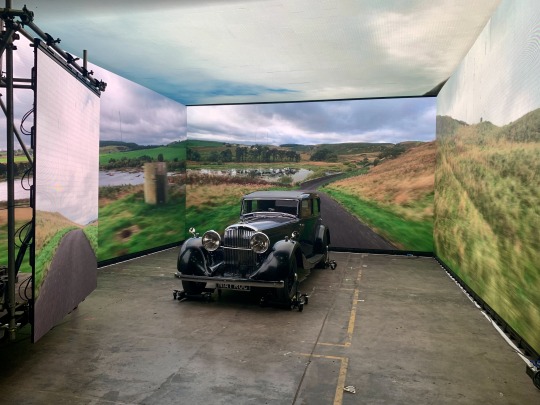
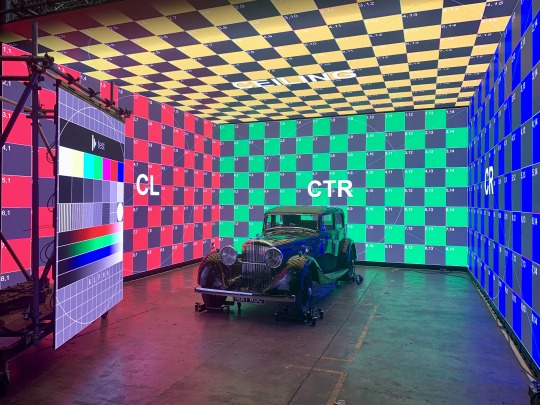
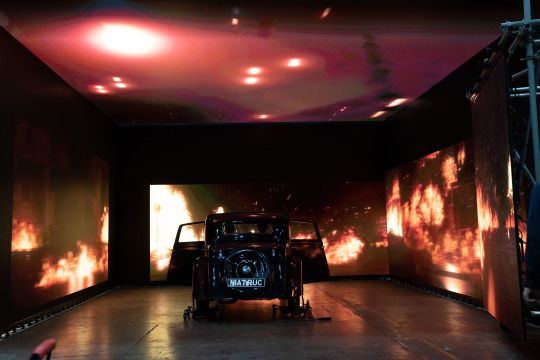
Shooting in the VR cube for the blitz scenes .
Finney took advantage of virtual production (VP) technology for the driving scenes in Crowley’s classic Bentley. The volume was built on their Scottish set: a 4x7m cube with a roof that could go up and down on motorised winches as needed. “We pulled the cars in and out on skates – they went up on little jacks, which you could then rotate and move the car around within the volume,” he explains. “We had two floating screens that we could move around to fill in and use as additional source lighting. Then we had generated plates – either CGI or real location plates –projected 360º around the car. Sometimes we used the volume in-camera but if we needed to do more work downstream; we’d use a green screen frustum.” Universal Pixels collaborated with Finney to supply in-camera VFX expertise, crew and technical equipment for the in-vehicle driving sequences and rear projection for the crucial car shots.
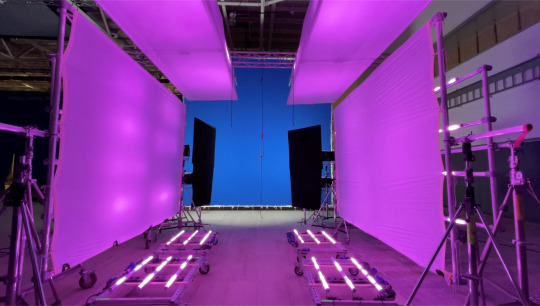
John Hamm was suspended in the middle of this lighting rig and superimposed into the feather tunnel.
Interestingly, while shooting at a VP stage in Leith, the team also used the volume as a huge, animated light source in its own right – a new technique for Finney. “We had the camera pointing away from [the volume] so the screen provided this massive, IMAX-sized light effect for the actors. We had a simple animation of the expanding universe projected onto the screen so the actors could actually see it, and it gave me the animated light back on the actors.”
Bringing such esteemed authors’ imaginations to the screen is no small task, but Finney was proud to helped bring Crowley and Aziraphale’s adventures to life once again. He adds: “What’s nice about Good Omens, especially when there’s so much bad news in the world, is that it’s a good news show. It’s a very funny show. It’s also about good and evil, love and doing the right thing, people getting together irrespective of backgrounds. It’s a hopeful message, and I think that that’s what we all need.”
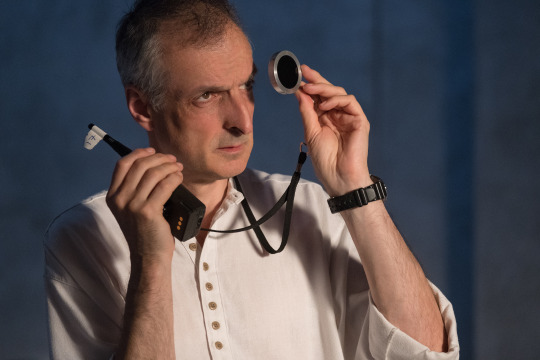
Finney is no stranger to the idiosyncratic world of Sir Terry Pratchett and Neil Gaiman.
#good omens#gos2#season 2#interview#gavin finney#neil gaiman#terry pratchett#gavin finney interview interview#s2 interview#bts#fun fact#british cinematographer#british cinematographer 2023#jon hamm#2ep1#2ep2#2ep3#2ep4#2ep6#2i1i1#job's minisode#1941 minisode#1827 minisode#2i6i7#bentley
2K notes
·
View notes
Text
Also preserved on our archive
Not covid specific, but good to remember: Masking and other airborne disease prevention keeps you from getting other diseases like the flu too. Covid's not the only threat to your long-term health out there.
By Felicity Nelson
A study of around 500,000 medical records suggested that severe viral infections like encephalitis and pneumonia increase the risk of neurodegenerative diseases like Parkinson's and Alzheimer's.
Researchers found 22 connections between viral infections and neurodegenerative conditions in the study of around 450,000 people.
People treated for a type of inflammation of the brain called viral encephalitis were 31 times more likely to develop Alzheimer's disease. (For every 406 viral encephalitis cases, 24 went on to develop Alzheimer's disease – around 6 percent.)
Those who were hospitalized with pneumonia after catching the flu seemed to be more susceptible to Alzheimer's disease, dementia, Parkinson's disease, and amyotrophic lateral sclerosis (ALS).
Intestinal infections and meningitis (both often caused by a virus), as well as the varicella-zoster virus, which causes shingles, were also implicated in the development of several neurodegenerative diseases.
The impact of viral infections on the brain persisted for up to 15 years in some cases. And there were no instances where exposure to viruses was protective.
Around 80 percent of the viruses implicated in brain diseases were considered 'neurotrophic', which means they could cross the blood-brain barrier.
"Strikingly, vaccines are currently available for some of these viruses, including influenza, shingles (varicella-zoster), and pneumonia," the researchers wrote in their paper published last year.
"Although vaccines do not prevent all cases of illness, they are known to dramatically reduce hospitalization rates. This evidence suggests that vaccination may mitigate some risk of developing neurodegenerative disease."
In 2022, a study of more than 10 million people linked the Epstein-Barr virus with a 32-fold increased risk of multiple sclerosis.
"After reading [this] study, we realized that for years scientists had been searching – one-by-one – for links between an individual neurodegenerative disorder and a specific virus," said senior author Michael Nalls, a neurogeneticist at the National Institute on Aging in the US.
"That's when we decided to try a different, more data science-based approach," he said. "By using medical records, we were able to systematically search for all possible links in one shot."
First, the researchers analyzed the medical records of around 35,000 Finns with six different types of neurodegenerative diseases and compared this against a group of 310,000 controls who did not have a brain disease.
This analysis yielded 45 links between viral exposure and neurodegenerative diseases, and this was narrowed down to 22 links in a subsequent analysis of 100,000 medical records from the UK Biobank.
While this retrospective observational study cannot demonstrate a causal link, it adds to the pile of research hinting at the role of viruses in Parkinson's and Alzheimer's disease.
"Neurodegenerative disorders are a collection of diseases for which there are very few effective treatments and many risk factors," said co-author Andrew Singleton, a neurogeneticist and Alzheimer's researcher and the director of the Center for Alzheimer's and Related Dementias.
"Our results support the idea that viral infections and related inflammation in the nervous system may be common – and possibly avoidable – risk factors for these types of disorders."
This study was published in Neuron.
Study link: www.cell.com/neuron/fulltext/S0896-6273(22)01147-3?_returnURL=https%3A%2F%2Flinkinghub.elsevier.com%2Fretrieve%2Fpii%2FS0896627322011473%3Fshowall%3Dtrue
#mask up#covid#pandemic#covid 19#wear a mask#public health#coronavirus#sars cov 2#still coviding#wear a respirator#flu#influenza#shingles#meningitis#varicella-zoster
236 notes
·
View notes
Note
Hi, first of all I wanted to say that I really appreciate your blog. Your political ramblings are always fun to read and still have the seriousness they deserve and I particularly like that you reference your sources, images and so on.
I did want to ask about those sources: how do you find them? Just a general internet search about a theme? Or some journals you read regularly (keeping in mind that medias have to be read with the context in mind of course) maybe even other blogs?
thank you and in any case I wish you to have a lovely day!
Hello! Thank you so much, this is so kind! Political blogging is something that just sort of happens to me. I never mean to do it. I'm glad others enjoy it anyway
Sources: so, there's a mix. I think I might have mentioned this before, back in the midst of Clownfall, but my husband is a Doctor Who nerd who, many years ago before social media was really much of a thing, joined a Doctor Who mailing list. There, he met many other nerds, and became friends with them.
They were a bit older than him, so grew up and got jobs and that before he did. Some of them became legit Doctor Who writers, like Paul Magrs and Lance Parkinson; but others, crucially, became political journalists. These people are now among the top political journalists in the land, so Steff gets tremendous amounts of news from them; previously on Twitter, and now on Bluesky, he therefore gets to see a lot of the headlines and memes and the like as they happen.
But, yes, a lot of it is also Google searching and hunting down sources that are as reliable as I can get them. I have a fair bit of professional practice at that part. A big thing is that modern newspapers often link back to previous articles about events that built up to whatever scandal you're researching, which is very helpful for making sure you get the background before you jump in; I also like cross-referencing between two or three reliable publications to see what details are generally agreed, and then making sure to link to the specific sources for anything that's only popping up once.
In my case, I also write these to be a bit funny? So that they're readable by people who are otherwise turned off by the dry wall of text presented by traditional politics reporting. So, I also amass a collection of memes and things by (a) getting my husband to save any he likes on Bluesky, and (b) checking the outputs of political comedians to see if they've produced anything fun. I got a LOT of mileage out of Michael Spicer's the Room Next Door sketches when trying to illustrate what various UK politicians were like.
In the case of yesterday's Korean martial law post, that was a bit trickier than normal because primary sources were obviously Korean (in which I can only say hello, yes, no, thank you, sorry, wow, and amazing). So, I did more cross-referencing than usual. If I could find three agreeing on a fact, I chucked it in (insofar as that was possible) - the times where that wasn't an option, I tried to include photo or video. But also, that was a broader strokes post than I'd normally do. In terms of the speed of development and the twists and turns that developed, it was possibly equivalent to Liz Truss' fracking vote? Which, if you compare the two, way more detail went into Truss because I was much surer of the sources. And, of course, that one was about my own country's political meltdown; I knew more already.
Anyway, I hope that answers your question. Have a great day!
83 notes
·
View notes
Text
Diana Rigg Vs. Nichelle Nichols
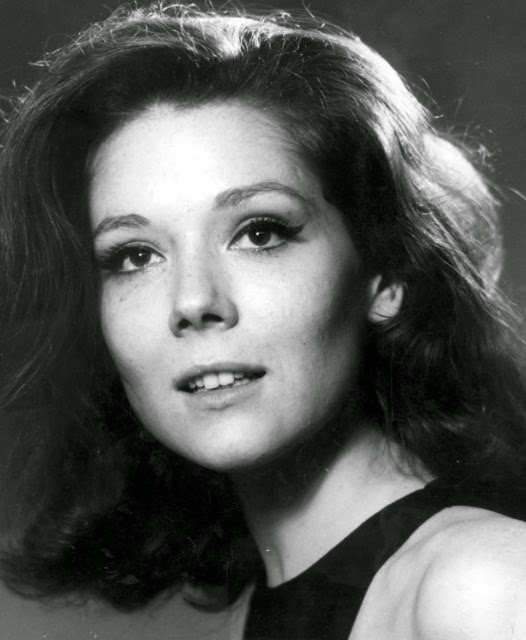
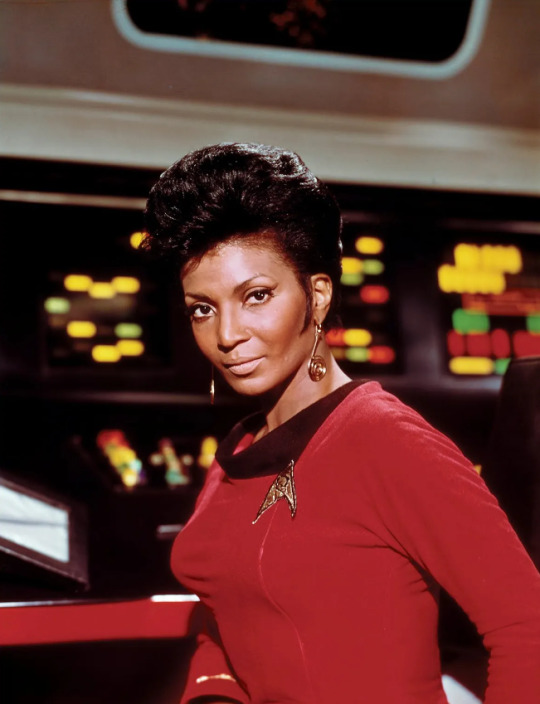
Propaganda
Diana Rigg - (The Avengers, Diana) - Honestly? Just check her out as Emma Peel in any episode of The Avengers. The character herself was a legend - an exceptional spy, wonderful fighter, certified genius, a true feminist role model - not to mention a renowned sex symbol (that leather catsuit... heavens help me...) and fashion icon. As for Diana personally, she was once described by Michael Parkinson as "the most desirable woman he ever met, who radiated a lustrous beauty". She could pivot from funny quips and endearing jokes to stone-cold badassery like it was nothing, and she looked stunning either way. Whenever I look at a pic of her, I have this feeling she's planning some fun mischief and I get the strongest urge to ask her to take me along. Need anything more? Here, have some pics: (pics below the cut)
Nichelle Nichols - (Star Trek) - She speaks for herself. Legendary, iconic, at the forefront of feminism and civil rights in the 60s, she is a triple threat who did so much more. She volunteered from 1977 to promote recruitment diversity within NASA, including some of the first female and ethnic minority astronauts. Martin Luther King Jr. compared her work on Star Trek as a 'vital role model' to the civil rights marches. She refused to be dismissed, fought for visibility and shone whilst doing so. As a woman in stem, and simply a woman she means the world and stars above to me.
Master Poll List of the Hot Vintage TV Ladies Bracket
Additional propaganda below the cut
Diana Rigg:
When people think of The Avengers, they think Steed and Peel (or they think the marvel property but that’s neither here nor there). I know people who thought Mrs. Peel was the ONLY woman Steed worked with, Diana Rigg was Just That Good (she was only on two seasons!). She was one of those actors that could so perfectly play comedy in any form, her dry, sardonic wit was marvelous, but so was her physical and slapstick comedy, and she could do drama too! If you’ve seen her in interviews you’d also know how fabulously humble and kind she was. I don’t know if I’ve ever been more attracted to a TV woman than I’ve been to Diana Rigg. Some photos of her:
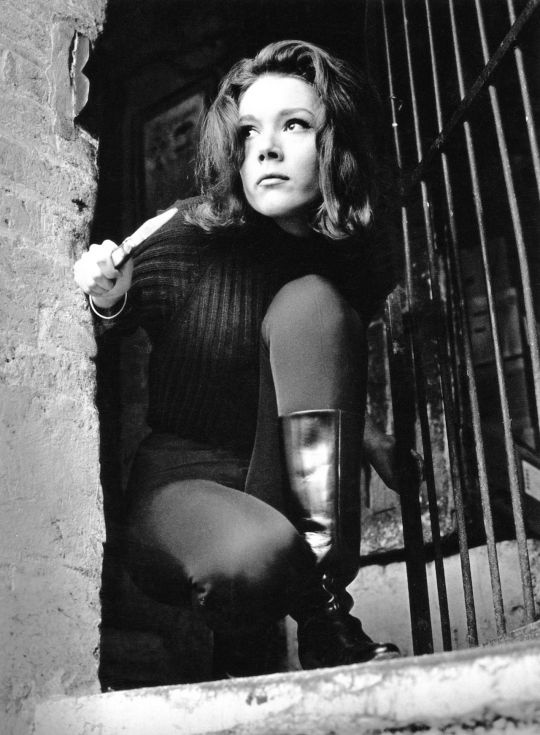
the SMILE!!!!
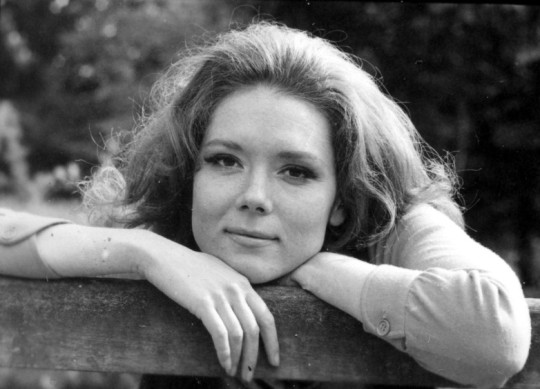
I like a woman that could kill me in one shot
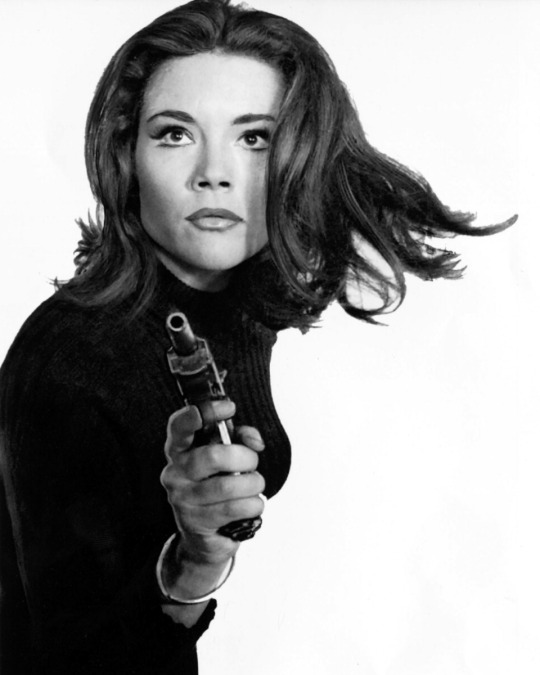
tell me she's not endearing I DARE you
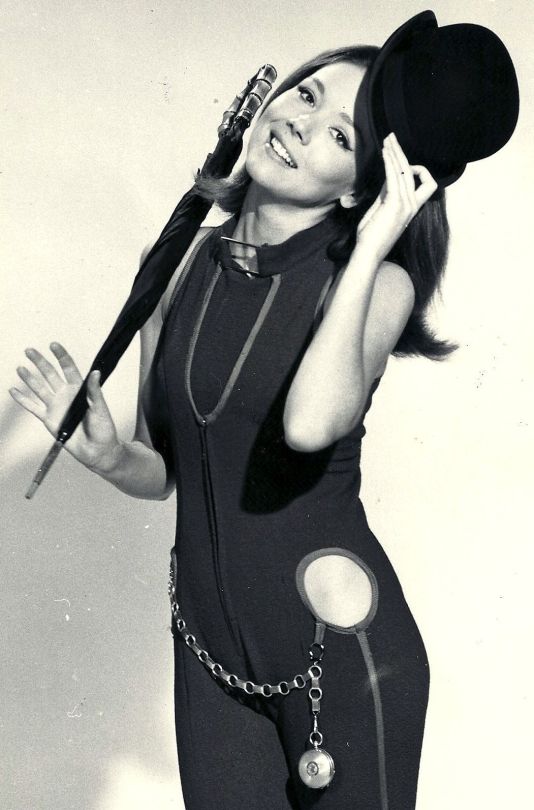
Gorgeous, sexy, competent, superior, so much leather. Diana Rigg as Emma Peel in the Avengers was foundational to my sexuality and personality. She's classy, she's cute, she's cocky, in one episode she whips a bunch of guys while wearing a corset and a spiked collar...
excuse me I'm overcome with sinful thoughts
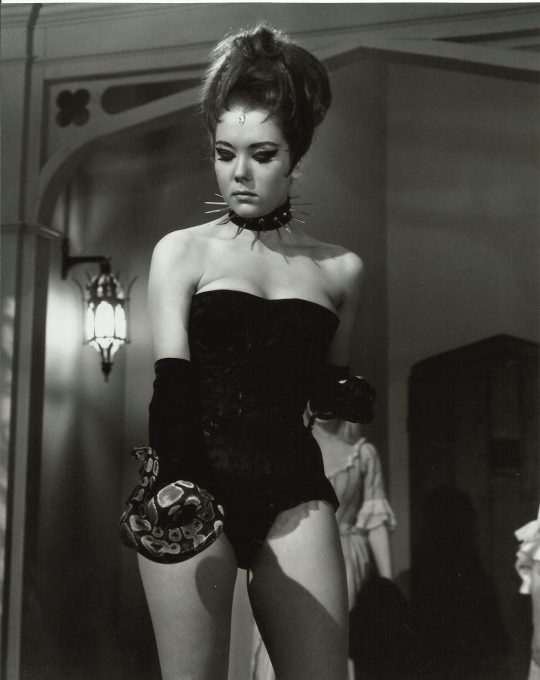
hello 911 I think I'm having a heart attack
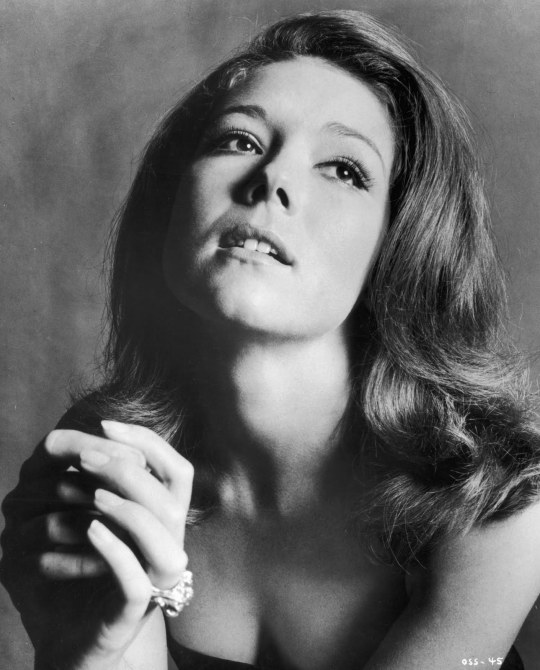
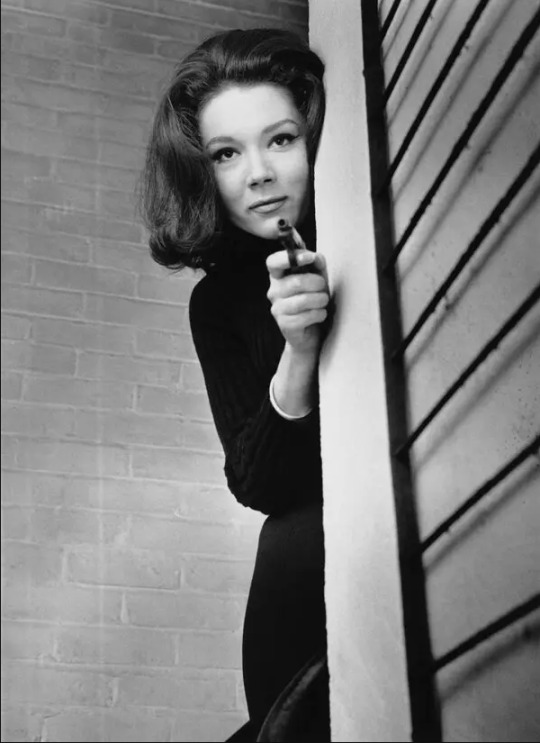

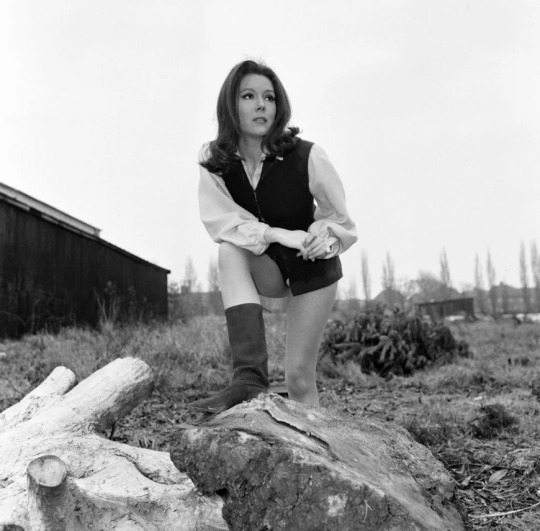
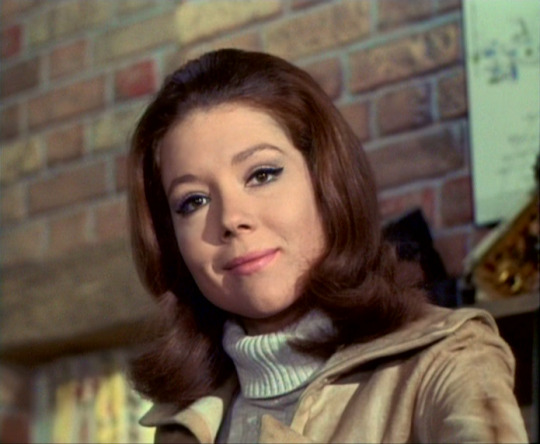
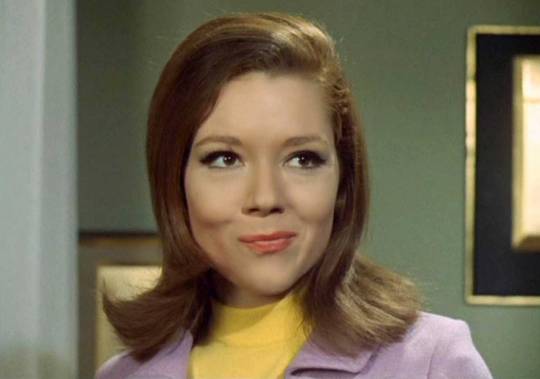
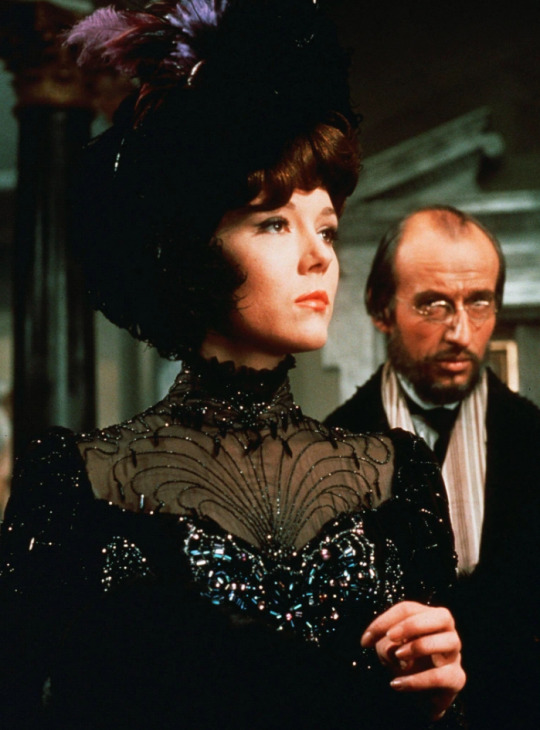
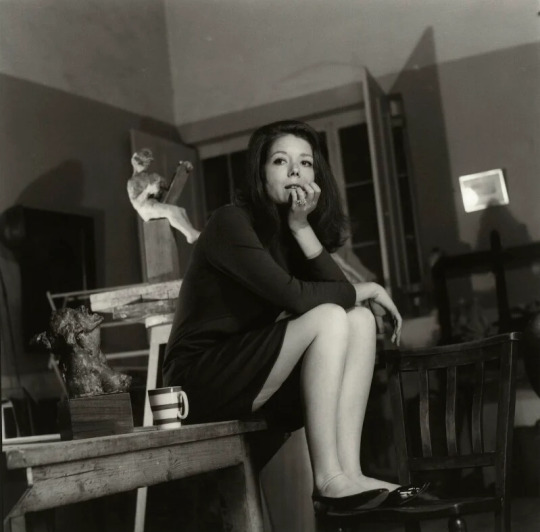
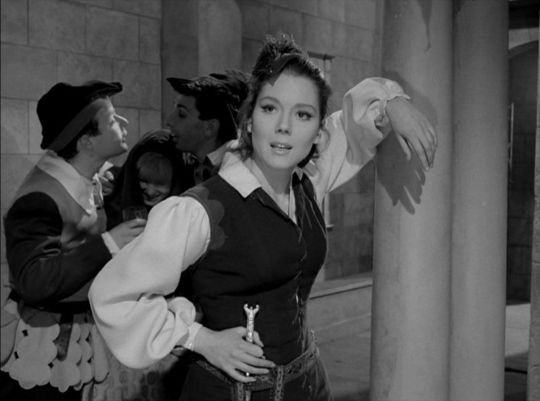
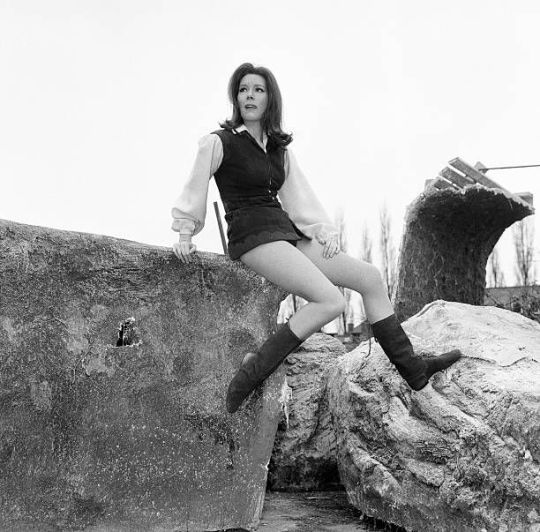
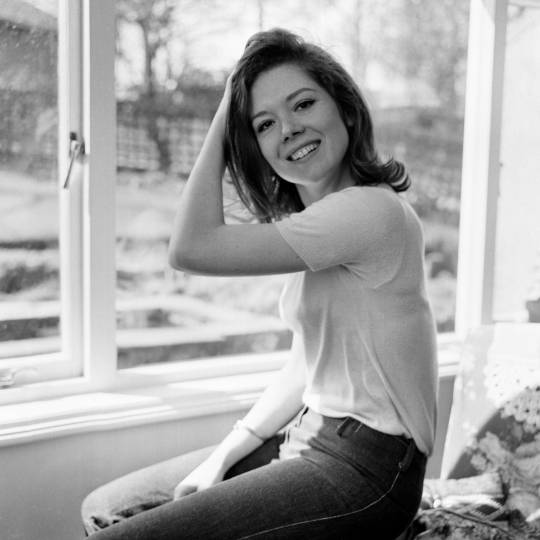
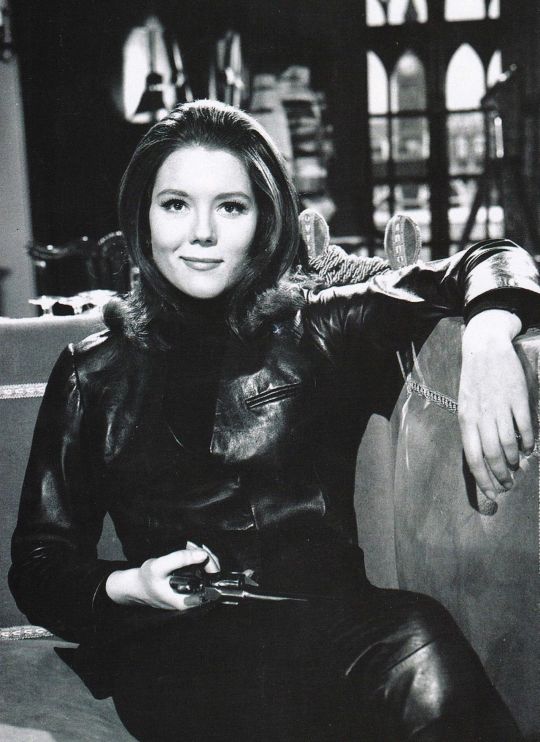
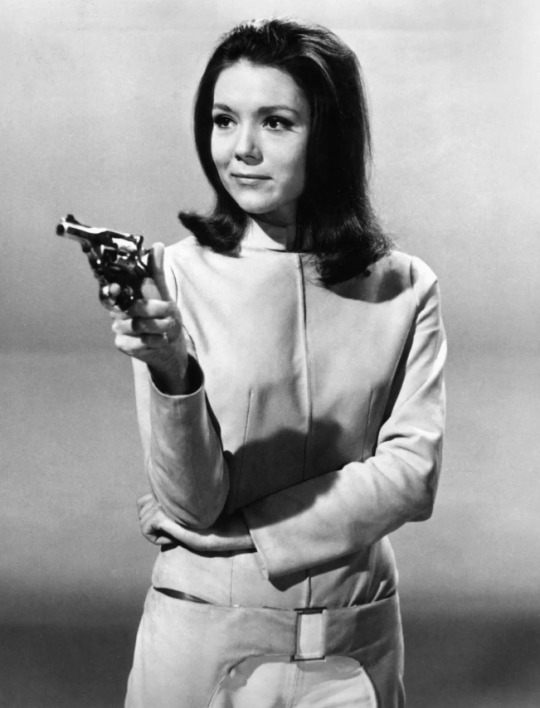
Here's an interview I fell for her in:
Diana Rigg | Interview | The Avengers | Good Afternoon | 1974 | Part one
youtube
Her first appearance in The Avengers (In series 4, if you can believe it):
The Avengers: Emma Peel First Appearance HD
youtube
Nichelle Nichols:
She is the original badass babe. She was a black woman in a leading role on TV in the 60s, a trailblazer for black actresses for years to come. She is so beautiful and so awesome.
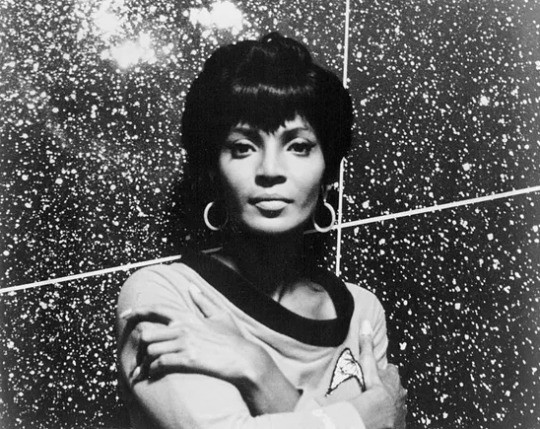
she's fantastic. have you seen her? paved the way for black actresses on TV even while her lines and scenes were being cut and improvised the most iconic uhura line in the series. (sulu: "I'll save you, fair maiden!" uhura, pushing him away: "sorry, neither!") she's incredibly talented and it's a crime the show didn't give her more screen time (or make her sing more often because she also has a beautiful voice!)
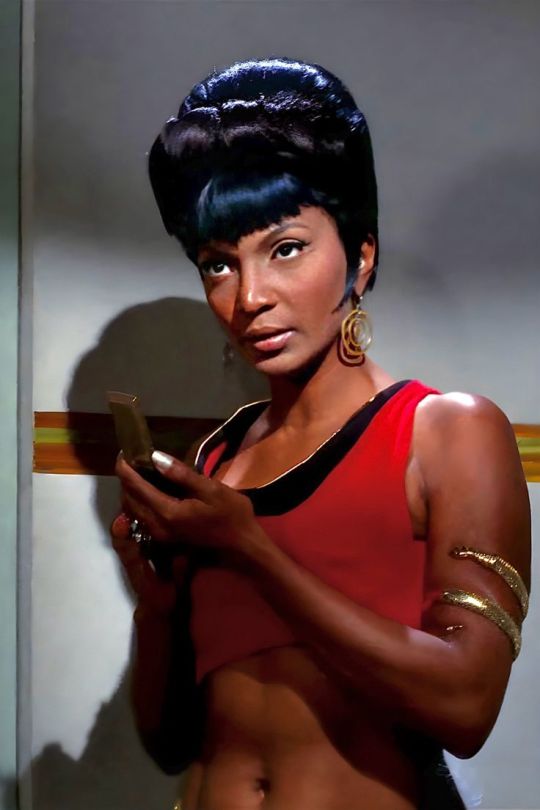
“Sorry, neither” in response to “fair maiden” was ad libbed by her. There’s a lot more I could say but what else do you need??

A sci-fi icon!

She was such a trailblazer, and Uhura was such an important character for so many people to be able to see on TV. Apparently Mae Jemison (the first African American woman to go into space) cited her as a reason she wanted to become an astronaut. She was just an absolute legend!
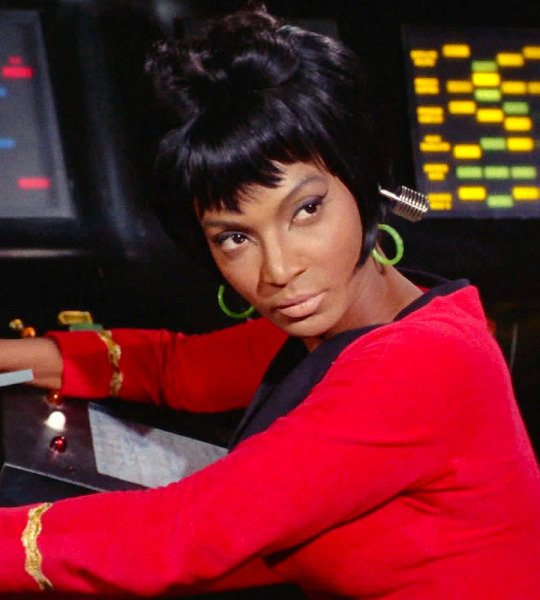
The story of Martin Luther King telling her not to quit Star Trek gives me chills. Representation matters. “Thank you so much, Dr. King. I’m really going to miss my co-stars.” Dr. King's smile, Nichols recalled, vanished from his face. "He said, 'What are you talking about?'" the actress explained. "I told him. He said, 'You cannot,' and so help me, this man practically repeated verbatim what Gene said. He said, 'Don’t you see what this man is doing, who has written this? This is the future. He has established us as we should be seen. 300 years from now, we are here. We are marching. And this is the first step. When we see you, we see ourselves, and we see ourselves as intelligent and beautiful and proud.' He goes on and I’m looking at him and my knees are buckling. I said, 'I…, I…' And he said, 'You turn on your television and the news comes on and you see us marching and peaceful, you see the peaceful civil disobedience, and you see the dogs and see the fire hoses, and we all know they cannot destroy us because we are there in the 23rd Century.'"
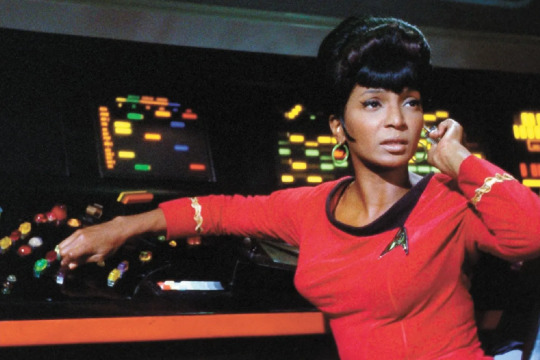
She shared the first interracial kiss on Star Trek, helped propel real life African American women into space-related careers, and looks divine in a mini skirt.
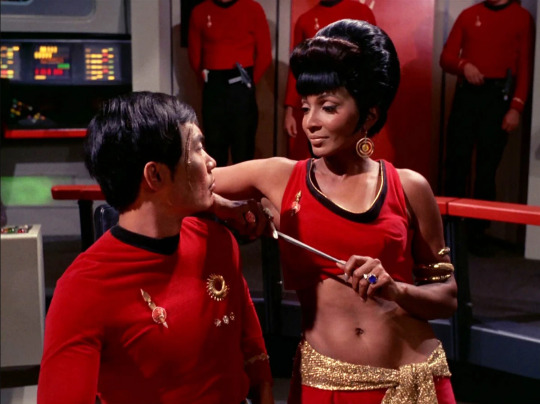
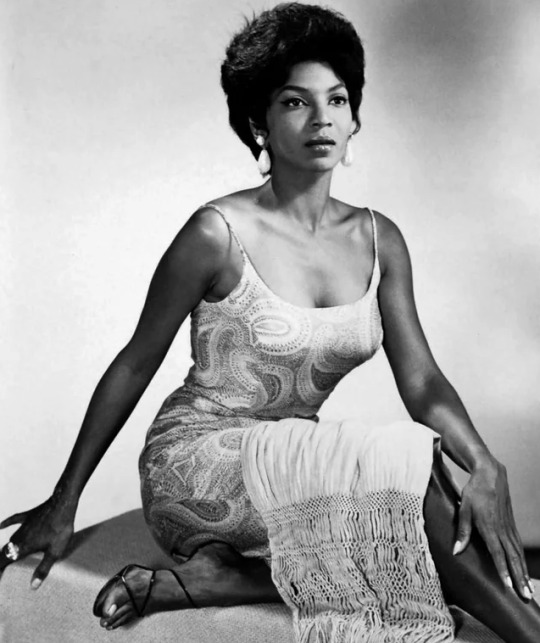

HOW DID UHURA WALK BACKWARDS SO FAR??? WOW!
150 notes
·
View notes
Text
Ways J.K Rowling did poc dirty in canon:
Making the last name of one of her most powerful black characters “Shacklebolt” - a crude af reference to slavery and just in very poor taste.
Naming her only east Asian character “Cho Chang” - a Korean surname as a first name for a Chinese character - proving she did no research whatsoever into Chinese naming traditions.
Cho’s characterization also leans in to the trope of tragic Asian female characters being defined by their romantic connections to white men, as in “Miss Saigon” or “A Quiet American.” Cho’s storyline centers on her romantic involvement with Cedric, Harry and Roger Davies. She gets no meaningful arc of her own.
The sidekick-ification of Lee Jordan.
Michael Corner being referred to as “the dark one” which is bad enough, and then him being whitewashed in the films.
Pansy Parkinson’s comment about Angelina Johnson’s braided hair looking like “worms” goes completely unpunished. Rowling treats this as standard bullying instead of a racially-charged comment. Rowling clearly didn’t understand the serious implications of this comment and its rooting in deeply-ingrained discrimination against black hairstyles, or she would have written a similar reaction to this as she did to that of Hermione being called a “Mudblood.”
House Elves as a metaphor for slaves is highly problematic because they are depicted as “liking” their enslavement and being complicit in it, much like the black slaves in “Gone With The Wind.” Despite Dobby being a beloved character, he is also seen as an anomaly for desiring freedom, and many other House Elves are depicted as grotesque, fawning, ridiculous or sinister. Pretty garbage metaphor for black slaves.
In Goblet of Fire Rowling describes a group of “African” wizards wearing “long white robes” and “roasting what looked like a rabbit on a bright purple fire.” This is just… *sigh* The way this is worded is very clearly just token exoticism and includes no genuine detail about their clothing, cultural food or nationality. It’s just “wow those zany rabbit-eating Africans and their purple fire.” Once again black characters are being used as examples of otherness rather than shown as human beings.
Rowling has openly admitted that she created a detailed backstory for Dean Thomas, one of the series’ few black characters, but did not include it in the books and included the backstory of Neville Longbottom, a white character, instead.
Approving the casting of a white actress in the role of Lavender Brown in the films, a character the majority of readers assumed was black.
The portrayal of Blaise Zabini’s “famously beautiful” black mother who was known for offing her husbands and taking their money. Like. Come on. Tbh she sounds like a queen but violent woc gold digger is still a shit trope.
Just the entire treatment of the Patil twins at the Yule Ball, the way Harry and Ron treated them and Rowling’s garbage attempt at describing their traditional clothing.
Padma Patil’s portrayal in Cursed Child as the stereotypical controlling Indian wife. The idea of ending up with her instead of Hermione being positioned as some kind of horrible alternate reality for Ron had very xenophobic undertones, and while Hermione is portrayed as black in the play, I don’t believe that Rowling originally intended her to be a black character nor that casting directors deliberately set out to cast a black actress as Hermione in Cursed Child initially.
#feel free to add on#harry potter#anti jkr#jkr mention#tw jkr#harry potter books#canon#hp text posts#hp memes#hp marauders#marauders era#marauders#hermione granger#dean thomas#angelina johnson#lavender brown#cho chang#house elves#s.p.e.w#race in literature#poc#poc representation
1K notes
·
View notes
Text
Finished Rivals… have things to say…
Spoilers obvs ——>
Eeeeeeeeekkkkkk!
If you go into this show knowing it’s gonna be big, bold, brash, and unapologetic about being those things, you’ll have a great time!
The hair, the costumes, the music (oh god, the music - who stole my playlist?!), the cast - just everything is dialled up to 200% and if you dare to question ‘is it good though?’ it just shrugs and cuts to another sex montage.
Let’s be honest, I came (ahem) for David Tennant, but honestly, I stayed for so much more. He is brilliant of course, he always is, and his ability to capture the exact centre of a Venn diagram of pathetic and evil is unmatched - nobody does it like he does. He draws sympathy for a truly awful character, and certainly made me headbutt a wall a few times wondering how Tony kept making such terrible decisions. (Also if someone could supply a montage of him shouting fuck with full passion I’d be very grateful) - as he got more pathetic I honestly couldn’t resist him. His destruction of the Declan set is one of the most laughably pathetic things I’ve ever seen and I was almost crying watching it.
Meanwhile, they’re bending over backwards to make us like Rupert and I just can’t do it. He also makes lots of terrible decisions (mostly with his dick of course) and for me it undermines the apparent ‘he loves Taggie’ thing. I just wish he’d go home and play with his dogs.
(Also Gertrude is my favourite character, just the best dog!)
Shout out to Victoria Smurfit who knocks it out of the park as Maud - she has some of the best line deliveries in the whole show, particularly as she prepares to leave for London and resume her career.
But honestly, my heart belongs to Freddy and Lizzie. If you’d told me I’d be grinning with happiness, with tears in my eyes, for a sex scene between Danny Dyer and Katherine Parkinson before I started watching this, I’d have called a doctor for you, but that’s the truth. They are spectacular and I adored them. I’ve never been a fan of Danny before, but he completely seduced me here, and I already loved Katherine (IT Crowd fans in our house) - but between them, they supplied the real ‘rooting for them’ heart of the series. I want to see them together in everything now!
Back to DT - the top tier irony of having his character win his first BAFTA and then have him clubbed over the head with it… priceless, and I personally suggest the academy honour him with a long overdue nod for this role simply in order to see him receive it with trepidation in case he gets bludgeoned with it. It even beat the joyous irony of Tony being all true blue and Tory after… well everything that went down this summer!
(Also, the way Tony passed the award to Cameron as they collected it made me think that if David had won this year for Crowley, he’d have absolutely asked Michael up on stage to give it to him because Aziraphale should share it)
And lastly… Love is a Battlefield is an excellent song, but I will never be able to listen to it again now. Oh pathetic-evil DT characters, please stop wobbling my moral compass (sorry, I’m writing Kilgrave fanfic right now so I’m all over the place in terms of right and wrong)
Anyway, it was great fun and I’ve told everyone to watch it, 80s references bingo cards at the ready!
#rivals#rivals spoilers#seriously spoiler central here#don’t click on the cut if you haven’t finished#tony baddingham#david tennant#danny dyer#katherine parkinson#and everyone else#but mostly these three
37 notes
·
View notes
Text
I'm so unexcited for the Christopher Nolan Odyssey Film.
There's so many things I'm just dreading, like as a mythology buff (admittedly, not an expert, just a bit of a special interest), I'm gonna lose it if a film guy starts mansplaining about Homeric hymns to me. Like, keep talking about how the suitors were actually doing what was right for the time and I will kick you in your shriveled nutsack.
I also saw the cast list and nearly shed a tear. They all have fucking iPhone face. I'm sorry, Tom Holland as Telemachus (potentially)???? Like, oh it's so sad your dad is missing and stuff, but did you remember to take your ozempic today? Like all the cast have iPhone face. Unless this is gonna be a weird modern retelling (which also worries me), I won't be able to imagine Zendaya as Athena (potentially) without her whipping out a Google pixel to text Zeus.
I was talking to people and we ended up making our own cast list of some of the major roles.
Cast List
Odysseus - Antonia Banderas
My mother saw him in Paddington 3 and has instructed me to include him as he is, in her words, "fit". In my opinion, someone like Liam Neeson, Mads Mikelson or Michael Fassbender. I just don't want a poorly disguised American accent. Like I get you might not get a Greek actor or even one with a similar accent, but please not a straight American accent or badly done accent.
Penelope - Michelle Yeoh
Nolan is rumoured to have cast Anne Hathaway, which I am also kind of fine with, so I'm not too worried about that. I think Michelle would be great as a cunning, loyal wife to Odysseus and I also think she could channel a great amount of contempt towards the suitors. I never find Anne Hathaway to be convincingly angry in scenes, distraught and afraid, yes, but I think Michelle could really embody that disgust Penelope has.
Athena - Cate Blanchet
I think Athena needs to be played by an older actor. I get the Gods are ageless, but she needs to give the appearance of wisdom and I think Cate Blanchet always looks like she's planning and thinking. The issue with Zendaya is not just that she has iPhone face, but she is too young. Your mind immediately says that she's too young to be that wise. It's a trait commonly associated with older people as it relates to experience, and Zendaya just doesn't look experienced.
Poiseiden - Gerard Butler
Hear me out, I think the Gods (other than Athena) should only appear in voice and not in person. For the scale of things, an actor floating in the air with cgi waves doesn't really look that menacing in the scale of things, especially compared to 50 boats. And I don't want a big cgi water monster thing either. I think the voice should carry on the waves, a shout accompanied by a crash of water, the temper rising as does the waves. I think it's more threatening to hear his voice booming as the boat is rocked, there's a fear of pissing him off more cause, if he gets much louder, you might just capsize. My mother wanted to also say, in a perfect world, it would actually be Billy Connolly, but he hasn't acted in years now due to Parkinson's. The rumour is that Nolan has cast Robert Pattinson and, while he was threatening as the Batman, I don't think it's the right kind of threatening required for the role. If he was doing this as a voice acting role, maybe, we know he has amazing range from the Boy and the Heron.
Zues - Patrick Page
Listen to Little Songbird or Hellfire and tell me he doesn't sound like Thunder. Moving on.
Circe - Nicole Kidman
Circe is a complex character and I think she needs to be portrayed that way. I don't want a young actor who beguiles older Odysseus with her youth. I need Circe to have that wisdom and experience that Penelope also has. I think it could be an interesting idea to even have them played by the same person. This all depends on how close the movie will be to the original epic anyway. My main stipulation is that she needs to remind Odysseus of Penelope.
Calypso - Lupita Nyong'o
The articles I've read actually suggest her as Circe, which I wouldn't mind either, I just wanted someone older for Circe. I think Calypso is also a complex character that must be portrayed as such. Essentially I think Lupita would be able to embody both the woman madly in love with Odysseus and also the Goddess keeping him here for her entertainment. From seeing her in Us, I know she has an amazing range and is able to show the threatening side to Calypso required. It doesn't work if it seems like Odysseus has the upper hand at any point.
Telemachus - Thomas Brodie Sangster
I really struggled here cause a lot of young actors look too modern for a lot of period pieces. It's also important that Telemachus isn't some chiseled, huge guy. I also think, given we would probably check in on him multiple times during the movie, Thomas is good at looking young and old at the same time. Another option would maybe be Joe Locke.
This post is long already so I'm not doing the rest of the characters. I have nothing against the actors Nolan has gone with, I just don't think they fit well. I'm also heavily biased from listening to Epic and Hadestown a lot.
Lmk your suggestions, as always, these are just my thoughts and a lot of them aren't even well thought out.
#the odyssey#odyssey#greek mythology#homeric epics#telemachus#poseidon#zeus#athena#circe#calypso#christopher nolan#epic the musical#hadestown#fancast
31 notes
·
View notes
Text
Anyway did you know the current Parkinson's medication they give is literally the same thing they were giving over 50 years ago. Did you know it requires SWALLOWING and the only option if you develop impaired swallowing from The Disease That Impairs Your Swallowing is to start crushing it and adding it to applesauce and when that stops working the only thing left is to have a fucking tube surgically installed leading to your stomach. Did you know there is not even a version that can be given by IV!!!! There WAS an oral disintegrating tablet but the manufacturer fucking discontinued it. 🙃
And this medication has to be given MULTIPLE TIMES A DAY (there is an extended release version but it is prohibitively expensive so we only give it to dad before bed. Fun fact it does not last until morning!) and it loses effectiveness over time until eventually it just stops working.
(There is a new continuous subdermal pump version but it only just got FDA approval in the US and it will be at least 10 months before it's covered by Medicare, you know, the insurance that probably like 99% of Parkinson's patients in the US* rely on???????? Also iirc it's the same medication just a new delivery route so the issue of developing resistance still applies!!)
(Did I mention that Medicare also does not cover the cost of a nursing home lololol and THOSE AREN'T FUCKING CHEAP.)
Did you know Parkinson's can cause dementia symptoms including loss of executive functioning to the point that sufferers lose the ability to make decisions, which leaves them vulnerable to abuse? And that the medication does not help the cognitive symptoms???
Did you know patients' breathing remains intact so what kills them is usually smth like aspiration pneumonia, bedsores, or a serious fall?
Thank god for Michael J. Fox btw, it fucking sucks he has to deal with this but he has done SO MUCH to get new research funded, which is probably why we're just now having new breakthroughs like the pump or discovery of biomarkers that can be used to diagnose the disease before symptoms manifest.
Anyway I know there are a lot of causes needing our attention now but if you can it would be cool if you donated to the Michael J. Fox Foundation here:
* This is hyperbolic, I don't feel like looking up the actual number (if they even track it). Parkinson's mostly affects old ppl and in the US old ppl have Medicare ok.
Also all of this is possibly specific to the US but that's where I am and we are not moving to a Whole New Country just to squeeze a couple more years of misery out of my dad. ✌️
#nonrebloggable bc I have not tracked down sources to confirm all of this#it's really just a rant#original#personal#also if you ever see anyone suggest that politicians give two shits about the elderly kindly tell them to shove their ageism up their ass#venting#also also knock it off with making fun of dementia just. in general. ty.
24 notes
·
View notes
Text
Just thinking aloud about fame, celebrity, and Pluto in Aquarius...
When Britney Spears was released from the conservatorship there were posts about how it's likely Britney might not be as internet-literate or socially appropriate as we'd like her to be, considering everything she went through. The posts encouraged others to be patient and understanding, and not to cancel her if she happens to make any mistakes.
Just now I saw a similar point about Gypsy Rose Blanchard. Now that she's released she intends to make herself very public online, but her entire life (32 years) has been spent in either one prison or the other. There are concerns for how she might adjust to the internet we know today, seeing as how she likely didn't get the opportunity to grow alongside social media the way the rest of us did.
In the 2024 Year Ahead Forecast from The Astrology Podcast they brought up the Pluto in Leo generation, and how that period of time and that generation relate to the making of our concept of "celebrity". They're also the generation that are holding on to power (like the presidents of the USA). Pluto in Leo gen is also unique because it's one of the only Pluto generations that is likely to live to their Pluto opposition, which is happening now. With this Pluto opposition, the pod talked about how the idea of who gets to be in power is likely to change. As well as our concept and relationship with "celebrities".
In 1991, Pluto in Scorpio (square to Pluto in Leo, if it matters. Whether it matters is still something I'm exploring here), Michael J. Fox was diagnosed with Parkinson's. I'm not actually sure how public illness was allowed to be previous to that. I just remember growing up how Michael J. Fox was something of a special case, and his celebrity status helped make massive leaps in awareness and research for Parkinson's.
Hollywood became big in the 1920's, when Pluto was in Cancer. While Pluto has been in the opposite sign, Capricorn, I feel like I've heard about a million celebrities coming out with illness. Justin Bieber, Selena Gomez, Bruce Willis. Recently, Celine Dion. If you Google it, there are lists of dozens of celebrities with chronic illnesses. Not to mention mental illness, which has become that much more public.
My feeling at this point is that there are themes of privacy, hidden and internal illness, and representation here that we've seen getting dug up from the Pluto in Cancer era. True crime stories from old Hollywood, being open about mental illness, exposing how child talents have been exploited by the industry, and of course, hidden afflictions to celebrities are changes we've seen around fame through the trine, Pluto in Scorpio, and opposition, Pluto in Capricorn.
Most obviously, though, who gets to be famous has changed the most in the last 20 years. It used to be only special, hand-picked people who got to be famous. Now it could be anybody with a cell phone.
I think of this blog post on the Aries Point by Ace (AliceSparklyKat), where they talk about how the angular points seem to manifest. They've noticed that celebrities whose Sun is at 0 degrees Cancer seem to be regarded as chameleon-like in their nationality, form, or culture, and those with 0 degrees Capricorn seem to be known for a peak example for one nationality, form, or culture. I wonder if this can be seen in this shift to influencer culture, particularly in the rhetoric that celebrities until now have been made to represent everybody. But now, after Pluto in Capricorn, we are much more aware of the consequences of not having fair representation of more nuanced, individual experiences. At first it was all about art and talent. Now, it's about the hard tacks of who gets what job and why, and the consequences of story. Very Cancer to Capricorn opposition coded.
Anyway, I feel like I've noticed a lot of celebrities becoming ill in the past, and now I feel like I'm seeing some "taboo" issues come up in influencer culture. I'm wondering about how this could be gearing us up for Pluto in Aquarius.
What do you think??? I really want to hear your thoughts!
94 notes
·
View notes
Text

Music As Medicine by Daniel Levitin
In this fascinating book, the neuroscientist makes a strong case for the therapeutic force of music, describing ways in which it can be a beneficial part of recovery for patients
That great music can up be uplifting, transportive, transcendent – and conversely sorrowful or deeply unsettling – is a given, but its power to heal in the medicinal sense strikes me as a much more difficult proposition to prove. In Music As Medicine, Daniel Levitin makes a valiant attempt to do just that, citing in his introductory chapter heavyweights such as Confucius – “Music produces a kind of pleasure which human nature cannot do without” – and Plato – “More than anything else, rhythm and harmony find their way into the inmost soul and take hold upon it”.
While both these statements attest to the deep pleasure to be derived from music – its soothing rather than healing properties – perhaps the most pertinent quote comes from the late Oliver Sacks, the neurologist and author of bestselling books such as The Man Who Mistook His Wife for a Hat and The Island of the Colourblind. Sacks was an enthusiastic piano player who, according to Levitin tackled Bach fugues “with great joy and exuberance”. He once described his clinical approach as essentially a musical one – “I diagnose by the feeling of discordancy or some peculiarity of harmony.” As Michael Rossato-Bennett’s 2014 documentary Alive Inside shows, the impact of music on people can sometimes be spectacular: one 92-year-old man, Henry Dryer, whose days in a nursing home were passed in a near catatonic state, suddenly became excited when played music from his youth – as Levitin puts it, “singing joyfully and reminiscing”.
Sacks’s writing, scholarly and informative, is the most obvious touchstone for Levitin’s popularising style. A neuroscientist and cognitive psychologist who trained at Stanford, he is now a professor of behavioural neuroscience and music at McGill University in Montreal. He temporarily forsook science for music in the 1970s, playing in various bands before becoming a music consultant and sound engineer for, among others, Santana, Steely Dan and Stevie Wonder. This unique dual perspective underpins his bestselling volume of 2006 – This Is Your Brain on Music, in which he explored the often complex ways we mentally process and emotionally respond to music, how and why we find some songs profoundly affecting, while others leave us cold.
Like that book, Music As Medicine merges research, theory and intriguing anecdotes about his interactions with musicians as well as patients to provide evidence of his contention that music not only functions as a temporary uplift or soothing balm in times of trouble, but possesses a much deeper restorative quality. In chapters that deal with trauma, mental health and pain, he delves into the ways music-based therapy can be a beneficial part of the recovery process. Collaborative songwriting workshops, for instance, have helped military veterans process their PTSD symptoms by, as Levitin writes, “gently and repeatedly exposing veterans to an artistic reinterpretation of their trauma”. Interestingly, listening to music is a more tricky undertaking in some trauma therapy – on one hand allowing patients to access deep emotions in a less overpowering way, while actually triggering PTSD in others.
Elsewhere, Levitin looks at how musicianship, like any kind of creativity, can be cruelly impaired by illnesses such as multiple sclerosis and Parkinson’s disease, but also how cognitive functioning can sometimes improve when artists re-engage with music in a different way after life-altering diagnoses. For a chapter that focuses on Parkinson’s disease, which affects the central nervous system, progressively impairing movement and cognitive ability, Levitin writes about two musicians whose lives have been altered by the illness. The American singer Linda Ronstadt, who was diagnosed in 2013, stopped performing when her symptoms made it increasingly difficult for her to sing. “What you can’t do with Parkinsonism is repetitive motions and singing is a repetitive motion,” she told Levitin. In contrast, Bobby McFerrin, a jazz singer renowned for his often astonishing improvisational skill, was diagnosed in 2016, but continues to perform, buoyed up by a health regime that includes pilates, physical therapy, breath work and the very act of singing itself. “I still have a mind that likes to play,” he tells Levitin, and it may well be this playful, fluid and spontaneous element of his gift that has enabled him, as Levitin writes, “to channel his musical energy as a force for symptomatic release”.
For me, Music As Medicine works best when Levitin grounds his ideas and explanations in these kinds of personal, and often deeply affecting, encounters. Elsewhere, as is often the case with popular science writing that valiantly tries to demystify difficult subject matter, I found myself struggling with the complexities of cognition, not to mention musical theory. The penultimate chapter, subtitled Précis to a Theory of Musical Meaning, is a blessedly rare case in point.
That apart, Music As Medicine will certainly make you think more deeply about the healing properties of music, particularly for those who perform. As Levitin says, “when we play an instrument (including singing), we are engaging more mental facilities that almost any other activity: motor systems, motor planning, imagining, sensory auditory processing, and – if we’re inspired – creativity, spirituality, pro-social feelings and, possibly, a state of heightened awareness coupled with calm known as the flow state.”
For all that, the spell cast by a great piece of music remains, for me, essentially elusive, somehow floating free from even the most penetrating attempts to demystify it. Indeed, as this fascinating book attests, the more you find out about our cognitive and emotional relationship with music, the more mysterious it seems – and sounds.
Daily inspiration. Discover more photos at Just for Books…?
10 notes
·
View notes
Text
508. Michael Dobson and Douglas Niles - H2: The Mines of Bloodstone (1986)

A high level module for AD&D this one gets the players to go deep into the titular mines to get in the middle of a deep gnomes vs. deep dwarves war (or if you prefer... let me google the spelling... svirfneblin vs. duergar war, there). Going even further down they eventually get to face Orcus that you can see in the cool Keith Parkinson cover art.

Following up on what was apparently a stand-alone module (H1: Bloodstone Pass) this module, like that one, aims to also use the Battlesystem rules for fights between big armies with gnomes vs. dwarves giving the excuse for the big battles.

The module was not very well received at the time because it felt like a bit of a jumble, with a kind of hack and slash ethos that was no longer popular in the game. It also felt unbalanced in terms of treasure and magical items which seem to be overly available throughout. These are problems that are frequent as the game gets to the later levels and one of the great difficulties in making good high level modules... which is why I suppose there aren't that many of them (that and the majority of campaigns calling it quits around level 10).

15 notes
·
View notes
Text
A small new trial published in the journal Nature Medicine describes what would be two firsts for Parkinson's disease, if they pan out: a diagnostic test and a potential immune-based treatment that works similarly to a vaccine. The research is still early, but researchers are excited by the prospect of advances for a disease that lacks good diagnostics and treatments.
The target of both innovations is alpha synuclein, a protein that takes an abnormal form in Parkinson's patients—aggregating in their brains and destroying nerve cells involved in motor and some cognitive functions. While researchers have long known that these proteins are involved in the disease, finding ways to measure and target them has not been easy.
The (potential) Parkinson's vaccine
The Florida-based biotech company Vaxxinity developed a vaccine, or what it calls an active immune medicine, to train the immune system to attack only abnormal versions of the protein—which are improperly folded—and not the regular forms. This would essentially help people's bodies treat themselves.
“The idea is that patients should recognize their own misfolded proteins, and it is personalized because their own immune systems are doing the work,” says Dr. Mark Frasier, chief scientific officer at the Michael J. Fox Foundation for Parkinson’s Research, which funded the testing part of the study.
The Parkinson's test
The new diagnostic test for Parkinson’s, which was developed by researchers at University of Texas and Vaxxinity, uses samples of cerebrospinal fluid to measure a person's levels of abnormal alpha synuclein. If the U.S. Food and Drug Administration (FDA) grants it full approval, it will become the first test for diagnosing Parkinson's. (The FDA classified it as a breakthrough device in 2019, a status that expedites access to innovative technologies where there is unmet need.) “Without [such a test], you’re kind of shooting in the dark,” says Mei Mei Hu, CEO and co-founder of Vaxxinity.
Alpha synuclein has been tricky to measure in the body for several reasons, says Frasier. While everyone has the protein, abnormal forms of it occur in relatively small amounts, so they're harder to detect via imaging. This type of alpha synuclein also tends to clump inside cells rather than outside of them, making it even harder to see. If clumps are large enough to become detectable, they can look structurally similar to amyloid or tau—the proteins implicated in Alzheimer’s disease—so imaging tests might misdiagnose people with Alzheimer’s rather than Parkinson’s.
Read More: Michael J. Fox: Chasing Parkinson's Treatments
The test overcomes those hurdles by cleverly exploiting normal forms of the protein. Parkinson’s experts believe that tiny amounts of abnormal alpha synuclein circulate in the spinal fluid of patients, but are too small to be detected through imaging. To run the new test in the study, researchers take normal forms of the protein in the lab and add them to samples of spinal fluid from patients; that prompts any misfolded protein that might be present in the samples to pull the normal proteins into misfolded aggregates, amplifying the signal for the abnormal form. Scientists then use a fluorescent probe to detect how much antibody to the misfolded protein patients generated, resulting in a biomarker, or stand-in for the treatment effect.
This test would be a critical advance because it makes it possible to identify patients with abnormal alpha synuclein at the earliest stages of the disease, when treatments might be more effective.
With more data from patients, researchers hope to further refine what different levels mean, so that the test will be able to tell not just if a person has Parkinson's but whether someone might be at a greater risk of developing it. Currently the test is only used in research studies, but more results like these—as well as data on whether the same process can be applied to blood samples—could speed the test to getting approved for wider use.
What the study found
The trial—conducted by researchers at the University of Texas, the Mayo Clinic, the Michael J. Fox Foundation for Parkinson’s Research, and Vaxxinity—included 20 people with Parkinson’s. It was just designed to test the safety of the approach, so the study only provided hints about the treatment's effectiveness. Everyone received three shots over nearly a year; some contained the treatment at different doses, and some contained a placebo.
Overall, people receiving the vaccine generated more antibodies against the abnormal alpha synuclein protein than those vaccinated with placebo, as measured by the Parkinson's test. Antibodies started to ramp up about four months after the vaccinations began.
“What is unique about our technology is that it can stimulate the immune system to produce very, very specific antibodies against toxic forms of alpha synuclein, and do it in a safe way, which is reassuring,” says Jean-Cosme Dodart, senior vice president of research at Vaxxinity and senior author of the paper.
According to the test results, about half of the patients in the trial showed high levels of antibodies against the misfolded alpha synuclein, and most of these patients received the highest dose of the vaccine. They also scored the highest on motor and cognitive tests. There were too few patients to adequately assess any changes of Parkinson’s symptoms, but the researchers believe that longer follow-up with those tests, and potentially more frequent or higher doses of the vaccine, could lead to improvements in those scores. “The results are very, very encouraging,” says Dodart.
“This paper demonstrates that in a small number of people, the vaccine is having an impact on misfolded alpha synuclein, which is really exciting,” says Frasier. “We are now in the biological era for Parkinson’s disease."
18 notes
·
View notes
Text
Characters
Hey folks, I had an idea. So I'm writing a fic called Once More, With Feeling, and I am about ready to put another chapter out, but at the same time I have also finished the character sheet of every character in my fic who goes to school at the same time as Harry (whew.)
So my idea was that I would release said character sheet and people could do asks pairing a character with a subject they liked (for example, Keiko Tanaka with older lesbian awakening) and I write them a chapter if I could, because 1. motivation and 2. it would be fun!
One note: please don't use any original characters without asking. I know there's still a chance that it will happen and maybe it's not fair to ask, and if so lmk, but if at all possible, if you are reading this, inherent creative copyright is the basis of all fanfiction and if we can't agree on that, so much of what we love wouldn't exist. If you ask I'm 100% amenable to the characters being used, but please ask.
Okay, without further ado, here is the list as of right now, with Harry as a first year. When I get to the next year I'll reblog with the new kids and without the seventh years. The * refers to an original character, and the (a) refers to a character that has already been introduced in the story, which doesn't mean they can't get a chapter written but means they may already have a bit of a personality.
Once More, With Feeling Characters!
First Year:
Gryffindor:
Hermione Granger (a)
Ron Weasley (a)
Harry Potter (a)
Neville Longbottom
Seamus Finnigan (a)
Parvati Patil (a)
Lavender Brown (a)
Dean Thomas (a)
Ravenclaw:
Cho Chang
Anthony Goldstein
Padma Patil (a)
Michael Corner
Lisa Turpin
Mandy Brocklehurst
Terry Boot
Morag MacDougal
Hufflepuff:
Ernie Macmillan
Hannah Abbott
Justin Finch-Fletchley
Wayne Hopkins
Sally-Anne Perks
Susan Bones
Lily Moon
Slytherin:
Draco Malfoy (a)
Pansy Parkinson (a)
Daphne Greengrass (a)
Tracey Davis (a)
Vincent Crabbe (a)
Gregory Goyle (a)
Theodore Nott (a)
Millicent Bulstrode (a)
Second Year:
Gryffindor:
Cormac McLaggen
Katie Bell
Poppy Lassers*
Juliet Torley*
Abraham Kent*
Callie Zeller*
Alfie McTuckett*
Ravenclaw:
Marcus Belby
Eddie Carmichael
Marietta Edgecombe
April Whiteflower*
Lila Webster*
Bellamy Schon*
Isabela Martin*
Hufflepuff:
Rob Summerby
Leanne Nott
Kenneth Towler
Tara Moon*
Jasper Davis*
Louie Nabbit*
Oscar Cross*
Slytherin:
Billy Harper
Hakim Urquhart
Emmeline Denkel*
Lola DeLuma* (a)
Ezra Fawley*
Finch Rowle*
Leopold McManus*
Third Year:
Gryffindor:
Fred Weasley
George Weasley
Angelina Johnson (a)
Alicia Spinnet (a)
Lee Jordan
Arthur Marrigan*
Ines Cardoso*
Scott Nunez*
Ravenclaw:
Roger Davies
Patricia Stimpson
Oona Sianche*
Asa Merrythought*
Molly Moon*
Catherine Prewett*
Fabler Murray*
Hufflepuff:
Cedric Diggory
Holly Hopkins*
Henrietta Noot* (a)
Maria Jimenez*
Teddy Torley* (a)
Phineas Borde*
Alabaster Borde*
Slytherin:
Miles Botchley
Graham Montague
Paula Cardoso*
Millie Wanewright*
Warwick Yarrow*
Barry Costman*
Madeline Morrisey*
Fourth Year:
Gryffindor:
Abelia Scott*
Keiko Tanaka* (a)
Fabian Cross* (a)
Elizabeth Benson*
Benjamin Denkel*
Peter Morebb* (a)
Steve Baumgarten*
Ravenclaw:
Sylvia Fawcett
Isobel Barclay*
Callum Marrigan*
Knox Wilson* (a)
Jacob Benowitz*
Mia Solendska*
Hufflepuff:
Juno Summers
Jameson Snock*
Johnny Ahmed* (a)
Amelia Wanewright*
Lauren Zeller*
Lizzy Beckett*
Slytherin:
Lucian Bole
Cassius Warrington
Adrian Pucey
Peregrine Derrick
Maryam DeLuma*
Seraphina O’Wane*
Zuzu Clapton*
Fifth Years:
Gryffindor:
Percy Weasley (a)
Oliver Wood (a)
Hank Murray*
Rachel Flick*
Mary (Matey) Nicks*
Bill Walters*
Zoey Lost*
Ravenclaw:
Penelope Clearwater
Claude Sollens*
Abigail Beck*
Robert Wailing*
Josh Browson*
Arabella Gardens*
Hufflepuff:
Michael McManus
Mabel Macmillan* (a)
Jenny Rosier* (a)
Wallen Exeber* (a)
Maya Ahmed* (a)
Odwulf Hausmann*
Sylvester Blink*
Slytherin:
Marcus Flint
Joey Markington* (a)
Philippa Morn*
Magdalena Fawcett*
Sebastian Swann*
Winter Barking*
Sixth Year:
Gryffindor:
Sophia Ferrate*
Romina Murray* (a)
Betty Sloper* (a)
Joe Spinnet* (a)
Thomas Denkel*
Darren Cross*
Yara Fawcett*
Ravenclaw:
Fergus FInnigan
Philip Baffler* (a)
Caroline Morian*
Diana Bow* (a)
Wesley Marrigan*
Dalia Ahmed*
Lucy Torley* (a)
Petrovna Berezkina* (a)
Hufflepuff:
Cara Smith*
Bennett Hopkins*
Hugh Madley*
Bruxo Castelan*
Finn Shamble*
Stella DuLuma*
Charlotte Pack*
Slytherin:
Cecilia DeTona* (a)
Faye Winger*
Astelan Smitt*
Robin Cospen* (a)
Terence Tackman*
Berto Conti*
Walter Mane*
Lea Shallan*
Seventh Year:
Gryffindor:
Reed Dennaghue*
Dorothea Bow*
Ernest Fluckster*
Wulfric Shee*
Kirk Dunbroch*
Sarah Fawcett*
Calliope Burns*
Patrick Torley*
Ravenclaw:
Gerald Biggs*
Tony Walden*
Zelda O’Heran*
Reginald Battes*
Morgana Abbott* (a)
Aurelian Dane*
Olivia Shee*
Hufflepuff:
Jada Shafiq*
Aster Rosier*
Norbert Caster*
Posy Kettleburn*
Helen McManus*
Tate Fawley*
Slytherin:
Terence Higgs
Clare Jameson*
Bettina Magorian*
Layla Ahmed*
Torey Denkel*
Timothy Starling*
Wander Fyke*
Sienna DeTona*
And that's it! Thank you!
#harry potter#harry potter fandom#harry potter fanfiction#dead gay wizards#harry potter marauders#golden era#golden trio#oliver wood#percy weasley#deamus#once more with feeling#jane is completely fine#list#hope this sounds fun!
7 notes
·
View notes